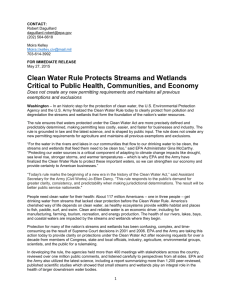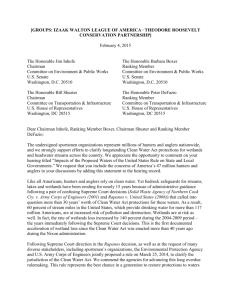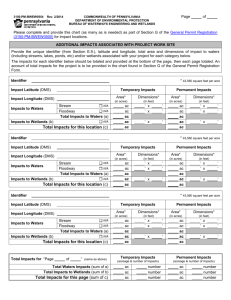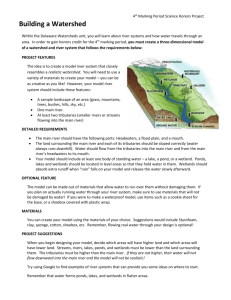StateNGOSign-OnLetterTemplate
advertisement
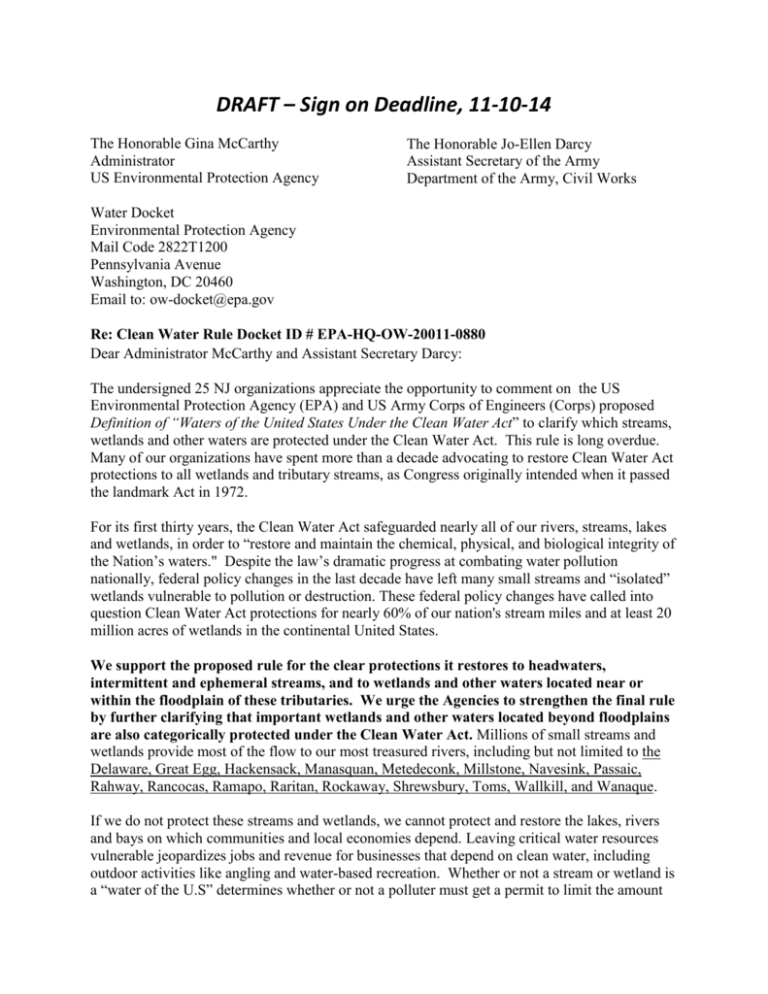
DRAFT – Sign on Deadline, 11-10-14 The Honorable Gina McCarthy Administrator US Environmental Protection Agency The Honorable Jo-Ellen Darcy Assistant Secretary of the Army Department of the Army, Civil Works Water Docket Environmental Protection Agency Mail Code 2822T1200 Pennsylvania Avenue Washington, DC 20460 Email to: ow-docket@epa.gov Re: Clean Water Rule Docket ID # EPA-HQ-OW-20011-0880 Dear Administrator McCarthy and Assistant Secretary Darcy: The undersigned 25 NJ organizations appreciate the opportunity to comment on the US Environmental Protection Agency (EPA) and US Army Corps of Engineers (Corps) proposed Definition of “Waters of the United States Under the Clean Water Act” to clarify which streams, wetlands and other waters are protected under the Clean Water Act. This rule is long overdue. Many of our organizations have spent more than a decade advocating to restore Clean Water Act protections to all wetlands and tributary streams, as Congress originally intended when it passed the landmark Act in 1972. For its first thirty years, the Clean Water Act safeguarded nearly all of our rivers, streams, lakes and wetlands, in order to “restore and maintain the chemical, physical, and biological integrity of the Nation’s waters." Despite the law’s dramatic progress at combating water pollution nationally, federal policy changes in the last decade have left many small streams and “isolated” wetlands vulnerable to pollution or destruction. These federal policy changes have called into question Clean Water Act protections for nearly 60% of our nation's stream miles and at least 20 million acres of wetlands in the continental United States. We support the proposed rule for the clear protections it restores to headwaters, intermittent and ephemeral streams, and to wetlands and other waters located near or within the floodplain of these tributaries. We urge the Agencies to strengthen the final rule by further clarifying that important wetlands and other waters located beyond floodplains are also categorically protected under the Clean Water Act. Millions of small streams and wetlands provide most of the flow to our most treasured rivers, including but not limited to the Delaware, Great Egg, Hackensack, Manasquan, Metedeconk, Millstone, Navesink, Passaic, Rahway, Rancocas, Ramapo, Raritan, Rockaway, Shrewsbury, Toms, Wallkill, and Wanaque. If we do not protect these streams and wetlands, we cannot protect and restore the lakes, rivers and bays on which communities and local economies depend. Leaving critical water resources vulnerable jeopardizes jobs and revenue for businesses that depend on clean water, including outdoor activities like angling and water-based recreation. Whether or not a stream or wetland is a “water of the U.S” determines whether or not a polluter must get a permit to limit the amount of pollution that can be dumped into that water. In 2007, EPA estimated that 34% of individual NPDES discharge permits in New Jersey are for discharges into headwater streams, including some streams that do not flow year round. Clarifying that these streams fall under the Clean Water Act will ensure they are protected from pollution or destruction, and therefore better protect the quality and health of downstream tributaries and rivers. We support the Agencies’ proposal to define all tributaries as “waters of the United States,” including headwaters and small streams that may only flow seasonally. Headwater streams provide most of the flow to downstream streams and rivers, and make up 48% of New Jersey’s stream miles. Intermittent and ephemeral streams may only flow during parts of the year, but they support water quality in downstream waters by filtering pollutants and capturing nutrients and make up 6% of NJ’s stream miles. These streams, like the Pequannock are also critical habitat for fish and other aquatic species. Headwater and seasonal streams also feed the drinking water sources of 117 million Americans, including 4.3 million New Jerseyans. Clarifying that all tributary streams, regardless of size or frequency of flow are covered under the Clean Water Act will restore protections to 1,157 miles of streams in New Jersey that 48% of our residents depend on for drinking water. In addition, we support the Agencies’ definition of tributary and strongly agree that ditches should be defined as “waters of the U.S.” where they function as tributaries. There is sufficient scientific evidence that some ditches function as tributaries moving water and pollutants downstream. In those cases protection is important. We support the Agencies’ determination that all adjacent wetlands are “Waters of the U.S.” Wetlands perform critical functions that support aquatic life, clean drinking water and safeguard communities from floods. Wetlands protect the water quality of entire watersheds by filtering pollutants. They also store floodwaters, reducing flood flows that can threaten property and infrastructure. Wetlands also provide essential fish and wildlife habitat that support robust outdoor recreation and tourism. When wetlands are polluted, dredged or filled, these benefits are lost. The Great Swamp and Troy Meadows are critical for flood control and drinking water for downstream communities in Union, Morris, Essex, and Passaic Counties. Further communities with more wetlands along Barnegat Bay and the Delaware Bayshore fared much better from Super Storm Sandy’s storm surge than those that had less. In order to protect wetlands and other resources, we also urge the agency to: Categorically define certain non-adjacent “other waters” as “Waters of the United States” and identify additional subcategories of waters that are jurisdictional, rather than requiring case-by-case determinations. Wetlands and other waters, even so-called isolated ones that are not adjacent to tributaries, provide many of the same natural benefits as adjacent waters located within floodplains. In fact, it is because of their placement outside of floodplains that they function as “sinks” to capture and filter pollutants and store floodwaters, protecting the physical, biological and chemical integrity of downstream waters. Examples of “other waters” where the science supports our recommendation that they should be categorically protected by rule include: prairie potholes, Carolina and Delmarva Bays including in coastal New Jersey, Texas coastal prairie wetlands and vernal pools including in New Jersey’s Highlands and Skylands. Provide for new science by not categorically excluding any of the “other waters,” and establishing a process by which evolving science can inform jurisdictional decisions in the future. “Other waters” that cannot be defined as jurisdictional in the final rule should still be assessed on a case-by-case basis and provisions made for categorically including them as “Waters of the United States” if and when evolving science indicates that this is appropriate. New Jersey’s economy and local businesses depend on a safe, affordable and adequate water supply from tourism, recreation and fishing industries to food processors (M&M Mars, Anheuser-Busch, Goya Foods, Manischewitz …) and the pharmaceutical industry. For example, protecting small streams and wetlands is vital for fish and wildlife and New Jersey’s vibrant recreational industry. The U.S. Fish and Wildlife Service reports that New Jersey residents and nonresidents spent $2.3 billion on wildlife recreation, including $1.1 billion on fishing, in 2011. More than 2.4 million New Jersey residents participated in wildlife recreation activities in 2011. The Agencies’ commonsense proposal is based on the best scientific understanding of how streams and wetlands affect downstream water quality. The public benefits of the rule – in the form of flood protection, filtering pollution, providing wildlife habitat, supporting outdoor recreation and recharging groundwater – far outweigh the costs. When finalized, this rule will provide the regulatory assurance that has been absent for over a decade, eliminate permit confusion and delay, and better protect the critical water resources on which our communities depend. Our organizations urge the Agencies to swiftly finalize a rule to clarify that all waters with a “significant nexus” to downstream waters are clearly protected under the Clean Water Act. We thank the Agencies for their efforts to protect these waters and look forward to working with them to finalize and implement a strong “Definition of Waters of the United States under the Clean Water Act.” Sincerely, Association of NJ Environmental Commissions Bergen Save the Watershed Action Network (Bergen SWAN) CATA, The Farmworkers Support Committee Citizens United for Renewable Energy (CURE) Clean Water Action Climate Mama Comeback Farms Delaware Riverkeeper Environment New Jersey Food & Water Watch Genesis Farms GRAMMES Greater Newark Conservancy International Brotherhood of Teamsters- Port Division NJ Environmental Lobby NJ Highlands Coalition NJ Sierra Club NJ Work Environment Council North Jersey Pipeline Walkers Pinelands Preservation Alliance Raritan Headwaters Association Save Barnegat Bay Surfrider Foundation - NJ Unitarian Universalist Leg Min of NJ Waterspirit
